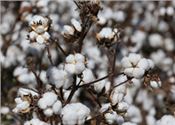|
Real-Time Weather Online To Aid Row Crop Producers

Once cotton reaches maturity, farmers apply a harvest aid to force the plants to drop
their leaves and open their bolls for harvest about two weeks later.
File photo by MSU Extension Service
STONEVILLE, MISS.
The Delta Agricultural Weather Center launched its real-time weather data website just as cotton producers were completing the 2017 harvest and anticipating next spring’s planting season.
Once cotton reaches maturity, farmers apply a harvest aid to force the plants to drop their leaves and open their bolls. They harvest the crop about two weeks later.
Cool, wet weather in the state associated with the remnants of three hurricanes – Nate, Irma and Harvey – slowed maturity and boll opening this fall, said Darrin Dodds, cotton specialist with the Mississippi State University Extension Service.
“Performance of harvest aid products is greatly impacted by weather, particularly the temperature,” Dodds said. “Growers tailor their harvest aid programs to the weather they have today and the weather they expect for the next five days. They have to stay fluid with it and adjust to the conditions they are given.”
The Delta Agricultural Weather Center’s website features the crop-management tools necessary to accomplish these goals, said Mark Silva, center coordinator and Extension associate.
“The purpose of the center is to help farmers make agricultural decisions,” he said. “The new site has been a long work in progress. Now, we can customize data reports for each station. This real-time weather data has been needed, and we’re proud that growers and researchers can have real-time data all the time.”
All Mississippi producers may access real-time, year-round temperature, rainfall, and wind speed and direction data from the center’s website to help them make crop decisions, Silva said. Information is updated every 15 minutes.
For cotton growers, the website has a planting recommendation map, based on the number of days when the temperature is above 60 degrees, the minimum level at which cotton grows. The map suggests times that are unfavorable, marginal or favorable for planting cotton. Planting recommendations are available through the site for many of Mississippi’s most common crops – such as corn, soybean and rice – as well as up-to-date results from various variety trials around the state, Silva said.
The website’s responsive design works on all types of devices, including cellphones, computers and tablets. Users may customize data reports from a choice of 15 stationary weather stations, most of which are located in the Mississippi Delta. Additionally, the website includes data collected from numerous mobile weather stations set up at MSU crop variety trial locations around the state.
“This is a very special weather network that we have,” Silva said. “It’s one of the main weather research facilities in the U.S., and people call from all over the country to get our weather data. Now, they can access it through this website.”
The Delta Agricultural Weather Center is a joint partnership funded by the MSU Extension Service, Mississippi Agricultural and Forestry Experiment Station, Mississippi Corn Promotion Board, Cotton Incorporated, Mississippi Rice Promotion Board and Mississippi Soybean Promotion Board.
The website is located at http://deltaweather.extension.msstate.edu. ∆
|
|